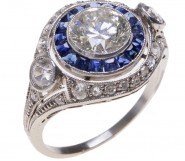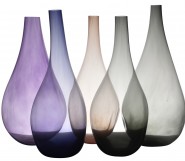Lot #10 - Ugo Catani
-
Auction House:Mossgreen
-
Sale Name:Fine Australian & International Art
-
Sale Date:21 Nov 2016 ~ 6.30pm
-
Lot #:10
-
Lot Description:Ugo Catani
(1859-1944)
Collins Street, Rainy Weather, 1887
oil on canvas
40.5 x 20.5 cm
signed, inscribed and dated lower right: Ugo Catani / Melbourne 87 -
Provenance:John Ambrose Kitchen, Melbourne; Thence by descent; Private collection, Melbourne
-
Exhibited:Winter Exhibition, Australian Artists' Association, Buxton's Art Gallery, Melbourne, October 1887
-
References:[Untitled] The Argus, Melbourne, 12 October 1887, p. 7; 'Social Gossip', Leader, Melbourne, 15 October 1887, p. 7; Jane Clark, 'Ugo Catani', in The Italian Connection: Italian artists in 19th century Australia; seminar papers, 9 October 1993, S.H Ervin Gallery, National Trust of Australia, New South Wales, p. 12
-
Notes:RELATED WORK: Collins Street, Rainy Weather (State Library of Victoria, Melbourne) Recently rediscovered after hiding for 130 years in a private collection in Melbourne, Collins Street, Rainy Weather, 1887 is an important addition to the oeuvre of Ugo Catani. Catani was one of several European artists who briefly, yet comfortably, settled into 'marvellous Melbourne' in the mid-1880s. All accounts suggest that 'Signor' Catani was as prolific as he was popular - a happy painter of portraits, genre subjects, landscapes and miniatures. Despite receiving consistently favourable contemporary reviews, his departure from Australia in 1894 signalled a brusque neglect of this singular figure in Australian art history. He was not brought back into view until 1993, when Jane Clark presented an exhibition on gli italiani - there was, and to some degree remains, a man and his art, ready to be re-discovered and re-evaluated.1 Although Catani lived a long and active life, most biographical particulars concentrate on his decade-long sojourn in Melbourne. We know he was born in Florence around 1859-1861, and that he initially followed in the footsteps of his father through jurisprudence studies. However, during a mountaineering excursion in Austrian Tyrol, (as one little known anecdote suggests), Catani injured his arm, forcing him to exchange his mountaineer's axe for the painter's brush.2 Between 1878-1883 he studied at the local Accademia di Belle Arti under obscure Giuseppe Ciaranfi. He probably painted alongside Cesare Laurenti, with whom he shared formal and stylistic similarities. It seems that poor health drove him to warmer climates, and together with Girolamo Nerli, he travelled to Madagascar, Mauritius, Bourbon (RŽunion), and Ceylon before landing in Melbourne in 1885. Here, Catani and Nerli, still in their mid-twenties and fresh off the boat, quickly set up a studio at 5 Collins Street. Soon after, they were sharing a studio with another recent arrival, Arthur Loureiro, and in 1891, with Walter Withers at Mutual Provident Building on Collins Street. Catani was an active and energetic organiser and promoter of the performing and visual arts. He directed several tableaux vivant, was known to have an operatic voice, and even wrote the libretto for an Italian opera - I due studenti. He enjoyed a series of fruitful relationships in Melbourne. Together with Tom Roberts, Frederick McCubbin et al., Catani was a founding member of the Australian Artists' Association (AAA). He went on to became a foundation council member for the Victorian Artists' Society (VAS) in 1888, where he showed his work until 1892. To supplement his income, Il fiorentino also gave art lessons, instructing young (mostly women) artists in Melbourne and Ballarat.3 Portrait painting also proved to be a steady source of economic sustenance. While in 1888 he is considered 'most at home' with genre subjects and still life works4, by 1890, with 'commission after commission', wrote one commentator, 'the artist is kept so busy at his work that he has little time for imaginative pictures.'5 Throughout his extended sojourn in Melbourne, he attracted the patronage of the city's wealthiest collectors including the Grimwade family, John Wagner, Theodore Fink, Sir Henry Loch and John Ambrose Kitchen. Nevertheless, declining health, or perhaps the devastating economic crash of the early 1890s, drove Catani to London where he was 'fast becoming known' for his portrait miniatures.6 It is a twisted and curious, if not singular, custom that only once Catani left Australia, was he considered an 'Australian artist'. Only then did the Melbourne journalists drop the 'Signor' salutation and begin referring to the young artist as 'Mr. Catani'.7 He returned to his native Firenze in 1923 where he would spend his dotage in obscurity. Collins Street, Rainy Weather, 1887 was first shown at the AAA's 'Winter Exhibition' held at Buxton's Art Gallery, Melbourne, in October 1887. To distinguish the present work from the (earlier) related canvas of the same title in the collection of the State Library of Victoria (SLV), a contemporary review and description firmly identifies the present painting as the one shown in 1887. 'Signor Catani', it was noted, 'exhibits a most realistic view of Collins Street on a rainy day. Looking east from Elizabeth Street you have a vista of the well-known buildings (including the new City Bank) enveloped in misty rain, while cabs, tramcars and pavements present such a slippery appearance that you positively feel cold and damp as you regard this powerfully painted picture.'8 Although both pictures represent the same subject (from different ends of the Street), the approach and finish is rather distinct. The SLV's version is closer to an exercise in photo-journalism in its precise rendering of detail in the commercial signage and architecture; even the air has a clean and limpid focus. The present work, by contrast, is more naturalistic in its style and execution. Although unlikely to have been executed en plein air, the image gives the sense of a momentary impression of the atmospheric conditions, with the distant cabs and buildings bleeding out of focus. This greater attention to the misty air suggests that Catani was absorbing more from his local colleagues - Tom Roberts and Arthur Streeton, in particular - than has previously been thought. This small work, depicting Collins Street from the doorstep of Catani's studio, is an important and rare work - both for its artistic value and as a singular snapshot of Melbourne City. It shows the (now demolished) City Bank, with its distinctive belfry on the corner of Swanston and Collins Street; further uphill is the spire of the old St Enoch's Presbyterian Church (also demolished); the composition is topped by the treasury building (saved from the nonsensical demolitions of the mid-twentieth century). Most artists in Catani's day - with the obvious exception of Tom Roberts with his Alegro con brio: Bourke Street West, painted the previous year - were busy depicting rural Australiana and its pastoral way of life and distinct light. Despite Melbourne being the second most populous city in the British Empire, second only to London, only a few artists were capturing the contemporary street-life of boom-time Melbourne. The present work being an exceptional addition to the genre. Purchased by John Ambrose Kitchen at the 1887 'Winter Exhibition' at Buxton's Gallery the work has been passed down four generations and is being offered here for the first time in 130 years. Collins Street Melbourne is a charming and rare example by a key artist in Australian late nineteenth century art. Petrit Abazi 1 Jane Clark, 'Ugo Catani', in The Italian Connection: Italian artists in 19th century Australia; seminar papers, 9 October 1993, S.H Ervin Gallery, National Trust of Australia, New South Wales, pp. 11-14 2 'Around the Melbourne studios', Illustrated Sydney News, Sydney, 1 August 1891, p. 6 3 'Advertisements', The Ballarat Star, Ballarat, 30 June 1886, p. 2 4 'Fine Arts', Leader, Melbourne 5 'Signor Ugo Catani', Table Talk, Melbourne, 19 September 1890, p. 7 6 'Studio Talk', The Studio Magazine, London, 15 September 1903, p. 288 7 'Australians Abroad', Australasian, 17 June 1905, p. 44 8 Social Gossip', Leader, Melbourne, 15 October 1887, p. 7. The example in the State Library of Victoria is probably the one exhibited in the window of Messrs Allan's music warehouse in December of 1885. See 'Art Notes', Argus, 12 December 1885, p. 5
-
Estimate:A$15,000 - 20,000
-
Realised Price:
-
Category:Art
This Sale has been held and this item is no longer available. Details are provided for information purposes only.










